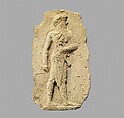Molded plaque: king or a god carrying a mace
Not on view
Ceramic plaques of this sort were mass-produced from molds and represent a form of art available to a wide audience. They have been excavated in temples as well as household shrines in private homes. Their subject matter varies widely, including religious images, mythological and erotic scenes, and representations of rulers and gods.
The figure on this plaque carries a mace or scepter and wears a short kilt and the round headdress of an Old Babylonian/Isin-Larsa ruler. His posture is erect and commanding, resembling that of Mesopotamian rulers of the Akkadian period on monumental relief sculpture. The mace held by this figure is often interpreted as a symbol of authority that has been invested by a higher power. Similar figures appear on cylinder seals, where they are usually depicted facing a suppliant goddess who intercedes with the gods on behalf of the seal owner. While some scholars have suggested that this figure is a god, it is likely that he is a king in warrior dress.
This image cannot be enlarged, viewed at full screen, or downloaded.

